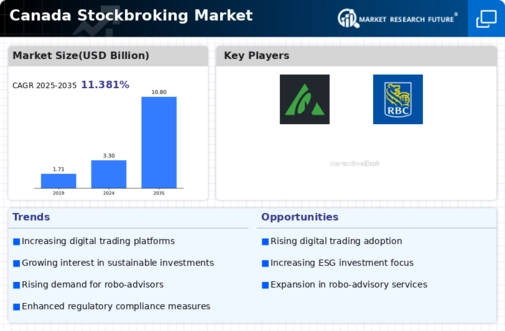Impact of Economic Conditions
Economic conditions play a crucial role in shaping the stockbroking market in Canada. In 2025, the Canadian economy is experiencing moderate growth, with GDP projected to increase by 2.5%. This economic stability is fostering investor confidence, leading to increased trading activity in the stockbroking market. Additionally, fluctuations in interest rates and inflation rates are influencing investment strategies among both retail and institutional investors. As economic indicators remain favorable, brokerage firms are likely to see a rise in demand for investment products and services. However, potential economic uncertainties could also lead to volatility in the stock market, prompting investors to seek more diversified portfolios.
Regulatory Changes and Compliance
The stockbroking market in Canada is influenced by ongoing regulatory changes aimed at enhancing market integrity and investor protection. In 2025, the Canadian Securities Administrators (CSA) introduced new compliance requirements that mandate greater transparency in fee structures and trading practices. These regulations are designed to safeguard retail investors and ensure fair competition among brokerage firms. As a result, firms are investing in compliance technologies and training programs to meet these evolving standards. This regulatory landscape is likely to reshape the competitive dynamics within the stockbroking market, as firms that prioritize compliance may gain a competitive edge in attracting and retaining clients.
Emergence of Sustainable Investing
The stockbroking market in Canada is increasingly influenced by the rise of sustainable investing, as more investors prioritize environmental, social, and governance (ESG) factors in their investment decisions. In 2025, it is estimated that ESG-focused funds represent over 25% of total assets under management in the stockbroking market. This shift is prompting brokerage firms to expand their offerings to include sustainable investment options, catering to the growing demand for socially responsible investing. As awareness of climate change and social issues continues to rise, investors are likely to seek out firms that align with their values, thereby reshaping the competitive landscape of the stockbroking market.
Growing Retail Investor Participation
The stockbroking market in Canada is witnessing a surge in retail investor participation, driven by increased accessibility to trading platforms and a growing interest in personal finance. Recent data indicates that retail investors accounted for approximately 40% of total trading volume in 2025, a significant rise from previous years. This trend is largely attributed to the proliferation of user-friendly trading applications and educational resources that empower individuals to make informed investment decisions. As more Canadians engage in stock trading, brokerage firms are adapting their offerings to cater to this expanding customer base. This shift not only enhances market liquidity but also fosters a more diverse investment landscape within the stockbroking market.
Technological Advancements in Trading
The stockbroking market in Canada is experiencing a notable transformation due to rapid technological advancements. Innovations such as algorithmic trading and artificial intelligence are enhancing trading efficiency and accuracy. In 2025, it is estimated that over 60% of trades in Canada are executed through automated systems, which significantly reduces transaction times and costs. This shift towards technology-driven solutions is attracting a younger demographic of investors who prefer mobile and online trading platforms. As a result, traditional brokerage firms are compelled to adapt their services to remain competitive in the evolving stockbroking market. Furthermore, the integration of blockchain technology is anticipated to streamline settlement processes, thereby increasing transparency and security in transactions.

















Leave a Comment